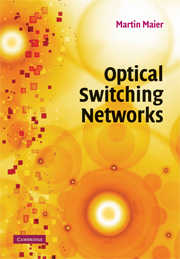Book contents
- Frontmatter
- Contents
- List of illustrations
- List of tables
- Preface
- Acknowledgments
- Part I Introduction
- Part II Optical wide area networks
- Part III Optical metropolitan area networks
- Part IV Optical access and local area networks
- Overview
- 14 EPON
- 15 WDM EPON
- 16 STARGATE
- 17 Gigabit Ethernet
- 18 Radio-over-fiber networks
- Part V Testbeds
- Bibliography
- Index
14 - EPON
from Part IV - Optical access and local area networks
Published online by Cambridge University Press: 10 May 2010
- Frontmatter
- Contents
- List of illustrations
- List of tables
- Preface
- Acknowledgments
- Part I Introduction
- Part II Optical wide area networks
- Part III Optical metropolitan area networks
- Part IV Optical access and local area networks
- Overview
- 14 EPON
- 15 WDM EPON
- 16 STARGATE
- 17 Gigabit Ethernet
- 18 Radio-over-fiber networks
- Part V Testbeds
- Bibliography
- Index
Summary
Access networks connect business and residential subscribers to the central offices (COs) of service providers, which in turn are connected to metropolitan area networks (MANs) or wide area networks (WANs). Access networks are commonly referred to as the last mile or first mile, where the latter term emphasizes their importance to subscribers. In today's access networks, telephone companies deploy digital subscriber line (xDSL) technologies and cable companies deploy cable modems. Typically, these access networks are hybrid fiber coax (HFC) systems with an optical fiber–based feeder network between CO and remote node and an electrical distribution network between remote node and subscribers. These access technologies are unable to provide enough bandwidth to current high-speed Gigabit Ethernet local area networks (LANs) and evolving services and applications (e.g., distributed gaming or video on demand). Future first-mile solutions not only have to provide more bandwidth but also have to meet the cost-sensitivity constraints of access networks arising from the small number of costsharing subscribers.
In so-called FTTX access networks the copper-based distribution part of access networks is replaced with optical fiber (e.g., fiber to the curb [FTTC] or fiber to the home [FTTH]). In doing so, the capacity of access networks is sufficiently increased to provide broadband services to subscribers. Due to the cost sensitivity of access networks, these all-optical FTTX systems are typically unpowered and consist of passive optical components (e.g., splitters and couplers). Accordingly, they are called passive optical networks (PONs). PONs had attracted a great deal of attention well before the Internet spurred bandwidth growth.
- Type
- Chapter
- Information
- Optical Switching Networks , pp. 225 - 237Publisher: Cambridge University PressPrint publication year: 2008



